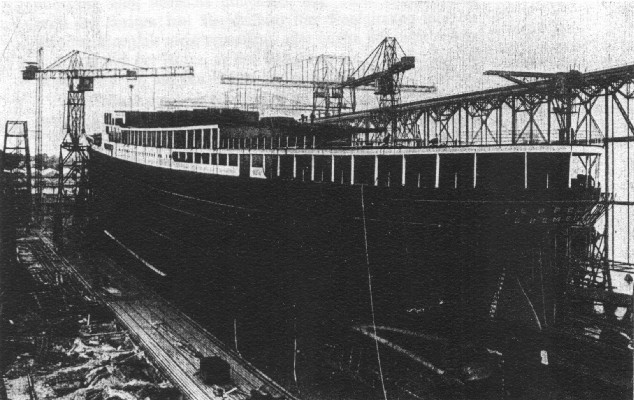| DIMENSIONS: | ||
| LENGHT : | 550 | ft |
| WidTH : | 67 | ft |
| DRAUGHT. : | 35 | fot |
| Passengers | approx 2000 | |
| DISPLACEMENT: | ||
| BRT : | 14690 | |
| NRT : | 7935 | |
| TDW : | ? | |
| ENGINE: | ||
| TYPE | QUAD STEAM | |
| POWER : | 10000 | IHK |
| HISTORY: |
| The building of Dresden was started in 1914, under the name of Zeppelin. Because of the circumstances (WW1), she was not commissioned until 1918. She was then handed over to England as part of the war settlement. P&&;O lines operated her under the name of "Ormuz", until 1927, when she was sold back to Germany and commissioned as a tourist liner by Norddeutche Lloyd finally as "Dresden". From 1933 she operated as part of the "Kraft durch freude" program, part of the Nazi propagandaapparatus. German workers and partymembers were given various welfare benefits like theatre performances, study circles...and cheap hollidays. At the same time there is also alledged intelligence activities on the cruises on the norwegian coast, but I do not know if it had started as early as 1934 |
| SHIPWRECK: |
| Dresden's last voyage started 18 June '34, was scheduled to go to the Hardangerfjord, but because of heavy fog, the captain settled for a trip in the Ryfylkefjords instead. Thursday june 20'th , Dresden was southbound when she ran aground at Aregrunnen, south of Bokn. Speed at the impact was approx. 9,5 knots. She was not stuck to the rock, but was taking in water through a big slash, and developed a list to port. The captain decided to head northward the Karmsund to run her aground a sandy beach. Probably in the Høievarde area, however, she was sinking fast and he was forced to pick the not so suitable bay of "Hestvik". The bottom here is rather steep and he had to make several attempts to make her stand. The crew of 323 and passengers (975) were saved by the ships "Stavanger", "Kvitsøy", "Kong Harald", "Kronprinsesse Martha" and a french inspection vessel. Most passengers were transfered by lifeboats except the last 500 or so, who were rescued by captain Pallesen and his crew who brought "Kronprinsesse Martha" alongside the listing Dresden. Pallesen was later awarded the a german rescue medal with ribbon and a diploma signed by Hitler himself. This contibuted to getting his son released from Grini during the war. All the passengers were rescued, except two which are rumoured to have died in hospital later, but we have no conclusive evidence of this. Very little of personal belongings were saved, and the local population provided the necessary clothing and lodging. The crew and passengers were transported back to Germany by the steamer "Stuttgart". The ship's bell was later given as a memento and is now displayed on the Kopervik quay. The inquiry did not reveal the real cause of the accident. ther were speculations that they had hit an uncharted rock, or that the navigation mark for Aregrunnen had the wrong position. The captain stated that the mark was 500 meter crosswise astern when they hit. |
| BREAKING UP: |
| The listing to port continued and salvage was impossible. Shipwreckers "Brødrene Anda" from Stavanger and an other company from Grimstad, I think got the rights to salvage scrapmetal. They continued the breaking up for several years. The the seabed by the engine room is at 30meters, making salvage difficult, and there also was a risk that the remaining wreckage would start to slide. The work was therefore abandoned just behind the engineroom. . |
| PRESENT CONDITION: |
| The stern still remains, sloping from approx 30 to 50 meter depth. The list to port is approx 20 deg.The highest point of the stern is at approx. 18 meter, sloping downwards to 35 meter. The rudder is at approx 50m, the propellers are blown away by the wreckers, there is a rumour that they miscalculated the explosive charge, so one propeller blade disappeared into deep water. The engine room area is completely cleared, just aft of it there are several rooms for utilities. Forward you can find remains of the hull, scattered sections containing galley, bathrooms, messrooms and so on. |
| DYKKING: |
| Because of the easy access, I think Dresden is one of the most frequently visited shipwrecks in this part of the world. Members of our club started diving there in the early 70's. There has also been a couple of serious accidents, due to the easy access, it also attracts inexperienced wreckdivers, and the sloping position makes it very easy to forget depth and time. Some of the old steelplates are severely corroded, making the edges sharp as knives. Wires are hanging down in some of the rooms, sections one could swim throug some years ago are now collapsed... If one takes due consideration of the conditions of this wreck, one can have a pleasant dive and survive, even without beeing a seasoned wreckdiver! Myself I lost track of my dives between one and two hundred. Still there are new things to see... |
 Fotografi fra Erik Bakkevigs samling Fotografi fra Erik Bakkevigs samling |